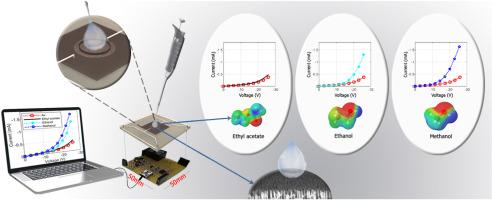Talanta ( IF 5.6 ) Pub Date : 2020-10-14 , DOI: 10.1016/j.talanta.2020.121769 Shiva Ashoori 1 , Maryam Naderpour 1 , Mohammad M Ghezelayagh 1 , Reza Malekabadi Zadeh 1 , Farshid Raissi 1

|
Nanosized particles can detect minute changes in surrounding electric fields via a phenomenon known as single-electron effect. Sensitivity can reach as much as counting single electrons. This phenomenon promises the possibilty of detection of atoms, molecules, cells or pathogens passing over or suspended around the nanosized particles whose IV characteristics is being monitored. Unfortunately, practical realization of such devices has been challenging because of their small size and low operating temperature, well below freezing temperature of regular liquids. Here we introduce PtSi/porous Si Schottky junction as a room temperature large size single-electron device capable of detecting very minute changes in the electric fields and hence identifying molecules, cells, and bacteria suspended or dissolved in liquid solutions. Encouraging results for detection of healthy and cancerous human cells as well as liquids and microorganisms are provided.
中文翻译:

使用单电子效应的超灵敏生物检测
纳米粒子可以通过称为单电子效应的现象检测周围电场的微小变化。灵敏度可以达到计数单个电子的程度。这种现象有望检测到原子、分子、细胞或病原体经过或悬浮在其 IV 特性正在被监测的纳米级粒子周围的可能性。不幸的是,由于此类设备体积小,工作温度低,远低于普通液体的冰点,因此实际实现这些设备一直具有挑战性。在这里,我们介绍 PtSi/多孔 Si 肖特基结作为一种室温大尺寸单电子器件,能够检测电场中非常微小的变化,从而识别悬浮或溶解在液体溶液中的分子、细胞和细菌。











































 京公网安备 11010802027423号
京公网安备 11010802027423号